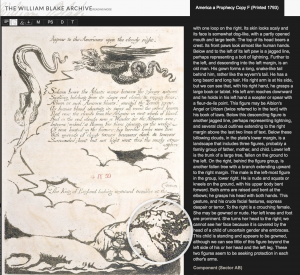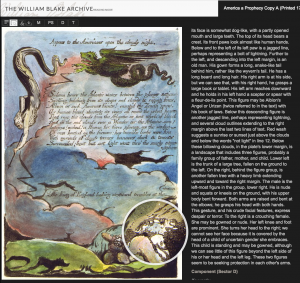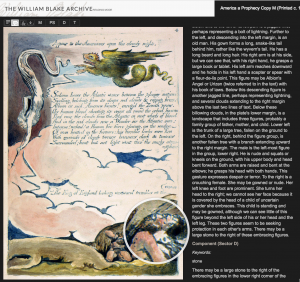Under the skilled eye of Katherine Calvin, I have completed training on illustration markup. With her help, I have gained practice in the art of seeing and of describing what I see, without inserting my interpretations. My introduction to the process of using templates to reflect on the new (to me) plate and spot the differences–a skill set that I first developed reading Highlights magazines–went smoothly. As I learned the ropes, there was only one instance where I thought the template itself was wrong.
The illustration description for the plate I was using as a template explains the figures in the lower right corner:
“Below these billowing clouds, in the plate’s lower margin, is a landscape that includes three figures, probably a family group of father, mother, and child […]To the right is a crouching nude figure. The heavy musculature suggests a male, but this may be a female. Her left knee and foot are prominent. She turns her head to the right; we cannot see her face because it is covered by the head of a child of uncertain gender she embraces. This child is standing and is gowned. These two figures seem to be seeking protection in each other’s arms.”
But what I saw was not what the last person who edited this template saw:

America, copy O, object 6, 1821, Fitzwilliam Museum
…and also maybe not what you see:

I do see three figures, with two that are embracing. But what I see is a bearded man and not a woman. His face is upturned, gazing (in apprehension? wonder?) at the vision above rather than hidden behind a child’s head. And I realize that this changes quite a lot, from the characteristics that I add and subtract:
<characteristic>female</characteristic>
<characteristic>male</characteristic>
<characteristic>gown</characteristic>
<characteristic>nude</characteristic>
<characteristic>crouching</characteristic>
<characteristic>kneeling</characteristic>
<characteristic>knee</characteristic>
<characteristic>left foot</characteristic>
<characteristic>holding</characteristic>
<characteristic>embracing</characteristic>
<characteristic>facing right</characteristic>
<characteristic>facing forward</characteristic>
<characteristic>facing left</characteristic>
<characteristic>facing up</characteristic>
<characteristic>looking</characteristic>
<characteristic>beard</characteristic>
<characteristic>long hair</characteristic>
to the adjustments that I make in the image description:
Below these billowing clouds, in the plate’s lower margin, is a landscape that includes three figures, probably possibly a family group of father, mother, and child […] To the right is a crouching nude figure. The heavy musculature and beard suggests a male, but this may be a female. Her His left knee and foot are prominent. SHe turns her head to the right; we cannot see her face because it is covered by the head of a and embraces a child of uncertain gender she embraces. This child is standing and is gowned. These two figures seem to be seeking protection in each other’s arms.
And then I wonder: what other modifications I should make, ones that veer toward the interpretive? Are the figures still “a family group?” Aeneas, Anchises, and Ascanius were. But that does not answer my question: does this difference require a home-wrecking alteration to the tags? Or another question: after this amendment about age and gender, are the embracing figures still “seeking protection in each other’s arms?”
What do you see? Do you see what I see?



